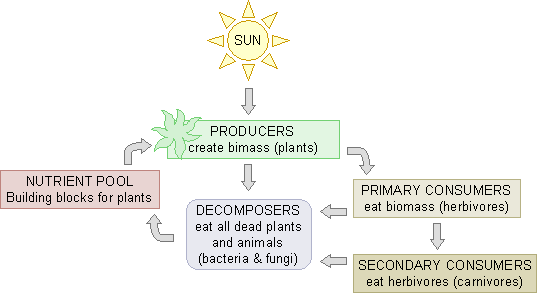|
Part 2: Basic Rangeland Ecology
Rangeland Ecosystem
The ability of rangelands to produce commodities for use
by ranchers largely depends on the balance between animals, plants,
and soil: the rangeland ecosystem.
All ecosystems consist of several interacting components:
- Producers are the plants that convert the
sun’s energy into plant material (biomass). In addition
to sunlight, plants require adequate water and other nutrients
from the soil.
- Primary consumers are the herbivores that
eat the plant material. Some consumers (such as cattle and sheep)
convert plant material into products (such as meat) used by secondary
consumers, including people.
- Decomposers (mainly bacteria and fungi) break
down materials, returning them to the soil so they can be re-used
by producers to make new biomass.
- The nutrient pool consists of the chemicals
(such as nitrogen and phosphorus) found in the living parts of
the ecosystem (plants and animals) and the non-living parts of
the ecosystem (soil and water); these chemicals flow through
the cycle of living and non-living components of the ecosystem.
Animals that are primary consumers are dependent on plant productivity.
Plants are dependent on the quality of the soil. Soil quality is
dependent on proper cycling of nutrients.
The interaction of these ecosystem components is crucial to the proper
functioning of the rangeland. Ecological disturbances involving these
components can be caused by nature and mismanagement. For this reason,
managers must consider all aspects of the range ecosystem and monitor
for potential impacts.

|